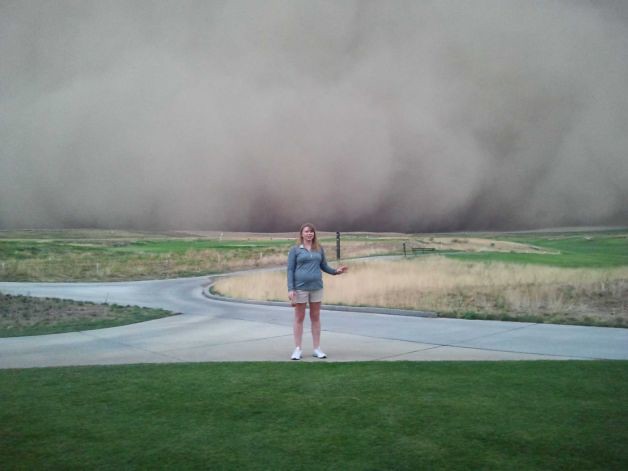By Camille St. Onge, Communications Manager
 |
| September 15. 2013. Photo by Heather Wegant, NBCRightNow.com |
In dry areas like Eastern Washington, dust is a
significant air pollution problem. If you live in Eastern Washington, you have probably
experienced the large desert-style dust storms known as haboobs.
From spring through fall, high winds in the Columbia Plateau region can combine with dry weather conditions to form strong winds that sweep up dust from farm fields and produce fierce dust storms. These dust storms can lead to extremely high levels of particle air pollution.
From spring through fall, high winds in the Columbia Plateau region can combine with dry weather conditions to form strong winds that sweep up dust from farm fields and produce fierce dust storms. These dust storms can lead to extremely high levels of particle air pollution.
While dust storms are not
uncommon in Eastern Washington, they sometimes are so extreme that they cause local air quality measurements to exceed federal
air quality standards.
Three unusual thunderstorms
That's what happened in 2013, when three unusual storms created
strong winds and dust in Eastern Washington. The storms overwhelmed
agriculture erosion controls and caused air pollution from dust to exceed
federal air quality standards. Ecology has developed a report about the storms which we will soon submit to the U.S. Environmental
Protection Agency. The report demonstrates
that these three strong wind storms were exceptional events and concludes they
were:
- Caused by nature.
- The cause of the high levels of particle pollution.
- Powerful enough to overwhelm the USDA-National Resource Conservation Service dust control measures in place throughout the area.
 An exceptional event is an
unusual or naturally-occurring event that can affect air quality, but cannot be
reasonably controlled. If a storm causes air quality monitor readings to go
over the federal limit and EPA agrees the reading was beyond our control and
meets other required criteria, the high reading may be considered an exceptional event. The high reading then would not count when determining whether
an area meets the National Ambient Air Quality Standards.
An exceptional event is an
unusual or naturally-occurring event that can affect air quality, but cannot be
reasonably controlled. If a storm causes air quality monitor readings to go
over the federal limit and EPA agrees the reading was beyond our control and
meets other required criteria, the high reading may be considered an exceptional event. The high reading then would not count when determining whether
an area meets the National Ambient Air Quality Standards.
Ecology
will ask the EPA to exclude the high level of particle pollution recorded
during these strong wind storms from calculations used to determine whether the region
meets the National Air Quality Standards. Excluding the high readings ensures the affected communities do not suffer significant impacts from an event that was beyond their control. Potentially, exceeding the air quality standards could impact transportation
planning, business permitting and federal highway funding.
Attend exceptional dust event webinar
If you’re interested in learning more
about Ecology’s report to the EPA, it’s easy to get involved. Ecology is
hosting a
webinar
at 1:30 p.m. Thursday, Aug. 13 to go over the report being submitted to the EPA.
To learn more about exceptional event dust storms read our FAQ or visit Ecology’s Outdoor
Dust web page.

No comments:
Post a Comment